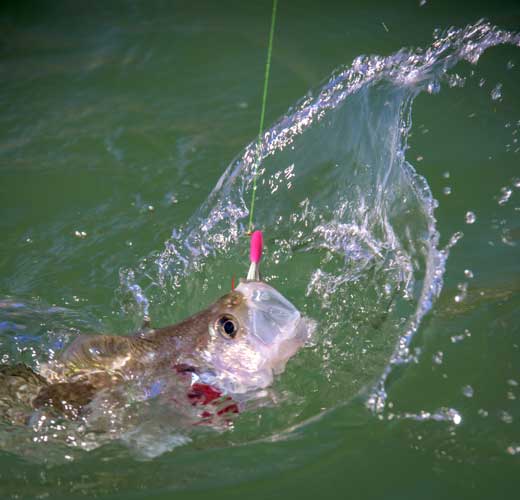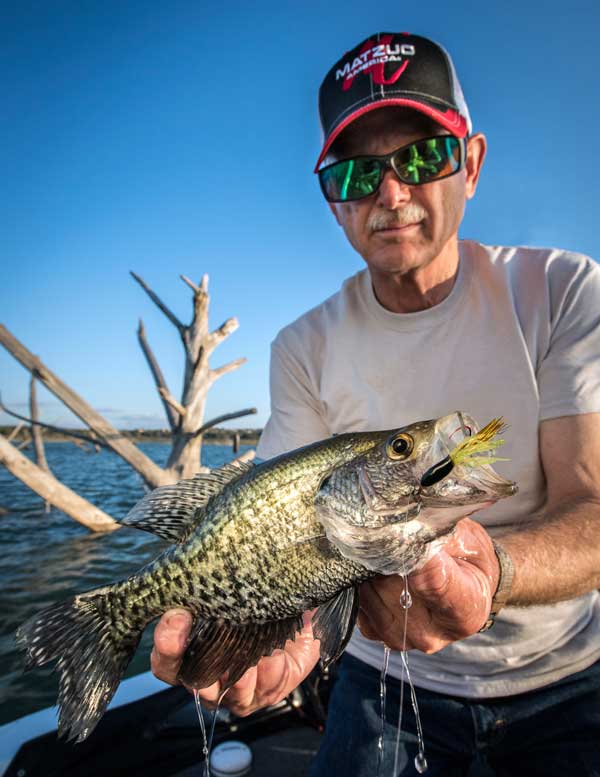Bass anglers oftentimes do not fish for crappie and crappie anglers do not fish for bass. In fact, disdain for each other is very common. However, each group could improve their angling skills by fishing for both species. The reasons: both bass and crappie relate to the same type habitat, both prefer the same basic water temperature, same spawning grounds and same food sources.

With all the similarities, it only makes sense to target both species to increase one’s overall knowledge base. As a fulltime bass and crappie fishing guide, my mental database has acquired many megabytes of useful data gained while fishing for both species. However, whether you are encouraged to reconsider your targeted fish species or not, there are relatively new advancements in hook design which improve hook-ups for bass and crappie anglers.
This hook design, called “Sickle®”, was introduced at the 2003 Fred Hall Fishing Tackle and Boat Show by Matzuo America®. The unique hook design received the coveted Tackle Tour’s “Best of Show” honor, for its category. Here is an excerpt from their March 19, 2003 publication: “Matzuo also showcased a patented hook design that features an angular bend. By applying these bends the Sickle hook gains a superior amount of strength and at the same time a thinner wire hook can be used for finer presentations of lures and bait. The thinner diameter wire also means that the hooks will be exceptionally sharp.”
That was twelve years ago when relatively few Americans had ever heard of Matzuo products. Today, Matzuo should be flattered by the number of quality angular hooks being produced by various companies that are similar to their patented design. There is only one reason for these other companies to invest and market similar angular designs…effective performance!
 The Matzuo website says their forged Sickle hooks are bent to an optimal 43.405 degree angle. In an effort to learn more, I emailed a request for additional information about the Sickle hook design. A couple weeks later I received a personal phone call with a follow-up email from Don Hoben, the now retired Matzuo founder and Sickle hook designer. In our conversation, I learned that Hoben’s vision was to create a hook specifically designed for people who jerk to set the hook (as opposed to pressure setting circle hooks) while retaining all the fish holding characteristics of the circle hook. His design inspiration came while catfishing in the Philippines. Realizing the direct relationship between hook sharpness, strength and shape to penetration, wire diameter and fish holding ability, he concluded, in theory, that an angular design could possibly solve all three troubling issues associated with round bend hook. After much trial and error, the Sickle hook design was created. What makes the 43.405 degree angle optimal, I will leave to the experts. I just know, from years of use, that the darn things work…remarkably. And, although I have no scientific evidence to substantiate the claims I am about to make, I do have loads of clients and a freezer full of fillets to bear witness to these claims regarding Sickle style hooks.
The Matzuo website says their forged Sickle hooks are bent to an optimal 43.405 degree angle. In an effort to learn more, I emailed a request for additional information about the Sickle hook design. A couple weeks later I received a personal phone call with a follow-up email from Don Hoben, the now retired Matzuo founder and Sickle hook designer. In our conversation, I learned that Hoben’s vision was to create a hook specifically designed for people who jerk to set the hook (as opposed to pressure setting circle hooks) while retaining all the fish holding characteristics of the circle hook. His design inspiration came while catfishing in the Philippines. Realizing the direct relationship between hook sharpness, strength and shape to penetration, wire diameter and fish holding ability, he concluded, in theory, that an angular design could possibly solve all three troubling issues associated with round bend hook. After much trial and error, the Sickle hook design was created. What makes the 43.405 degree angle optimal, I will leave to the experts. I just know, from years of use, that the darn things work…remarkably. And, although I have no scientific evidence to substantiate the claims I am about to make, I do have loads of clients and a freezer full of fillets to bear witness to these claims regarding Sickle style hooks.
1) The lighter gauge wire and super sharp points penetrate the fish’s mouth better even with lighter line and softer hook-sets (10 to 30% reduction).
2) Smaller diameter wire means that less damage is done to live bait causing the bait to stay alive longer.
3) Lighter wire means less weight to interfere with bait or lure action.
4) The deep-set angle next to the point, in conjunction with the angular throat bend design (rather than round bend), substantially minimizes the hook from rotating when the fish is slinging its head from side to side. Minimizing the hook rotation which effectively minimizes thrown hooks and lost fish.
5) The correct tensile strength of the lighter wire allows for enough flexing of the hook to pull lose when snagged.
A couple key points to remember about fishing with lighter weight wire hooks. Real hard hook-sets with heavier line WILL flex and bend the hook enough to miss the fish. This generally occurs with bass anglers learning to use light wire finesse drop-shot hooks before properly learning to down-size equipment in conjunction with softer hook-setting techniques. The other consideration is getting a stuck hook dislodged with light line. The proper method is to point the rod tip directly towards the lure or hook and apply firm steady pressure rather than trying to jerk it lose.
As far as I am concerned, the only real negative to the Sickle angular hook design is not having a broader selection of technique specific hooks available to the general public. Some companies are making limited quantities of specialized angular hooks designs for pros but, at this point, are not mass producing nor marketing to the general public. However, I am confident it’s just a matter of time, because the effective performance evidence is obvious.
For those who wish to test these Sickle style hooks, the following information will help with specific products to buy.
C rappie Fishing
rappie Fishing
1) Minnows – Matzuo #157 Aberdeen Sickle style, sizes #2 mostly and some #1. These are produced with extra thin wire in red chrome and bronze. I normally use red but cannot prove it makes a difference in numbers of bites.
2) Jigs – Round ball, minnow shaped and banana shaped with a spinner – Matzuo #149 90° Sickle jig hooks. Jig weights of 1/32 to 3/8 but most often about 1/8 oz with #2 hook.
Bass Fishing
1) Drop-Shot weedless – Owner Down Shot Offset #5333, sizes 1/0 to 3/0, mostly 2/0. These are used when snagging is problematic so rigging weedless (Texas style) is desired. They are not Matzuo’s patented Sickle but are a thin wire angular style which, hopefully, Matzuo will make in the Sickle design, someday.
2) Drop-Shot exposed hook – Matzuo Octopus Sickle Offset # 141, sizes 2 to 1/0, mostly 1. These hooks have slightly heavier wire.
3) Texas rigged worms – Matzuo Sickle J-Bend Worm # 142 and X-tra Wide Gap Worm # 143, sizes 1/0 to 5/0. Vary the size hook to the length and thickness of the worms. Example: Zoom’s 7” Trick worms work well with 3/0 #142 while Gary Yamamoto 5” Senkos work better with 3/0 # 143. These hooks, as well, are made with heavier wire.
Whether you are determined to fish only for one species or multiple, you should seriously consider and experiment with the new angular style hooks Matzo designed, patented and introduced to the market as “Sickle”. Ask yourself, why would other companies spend research and production dollars to market similar designs, if evidence did not support their effectiveness?
